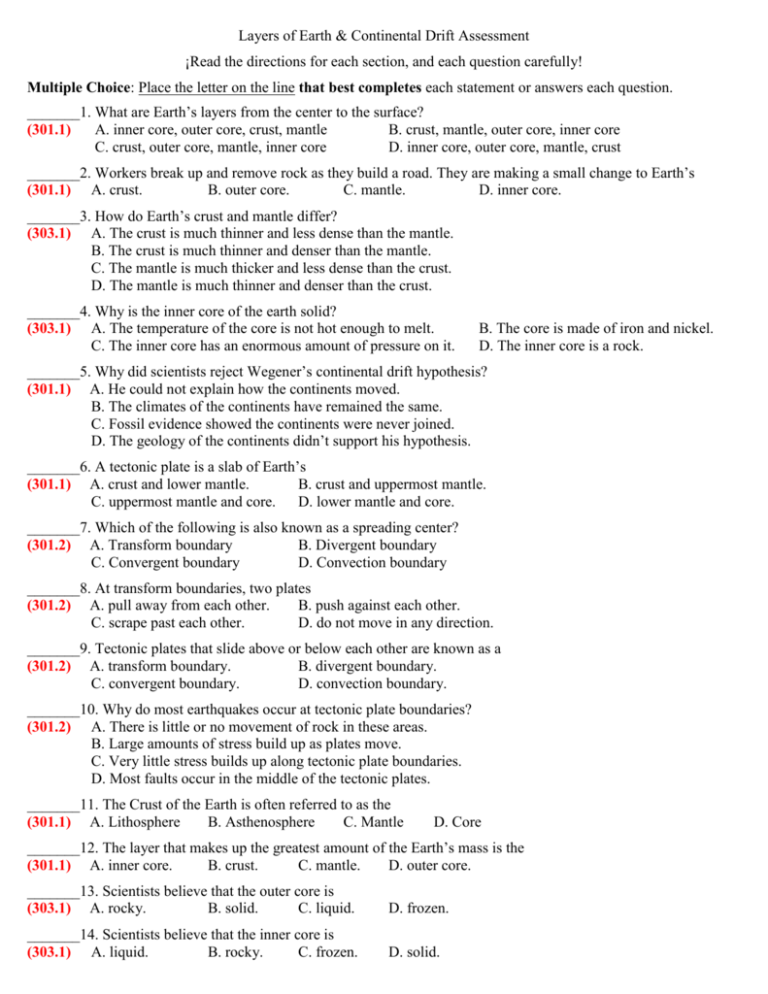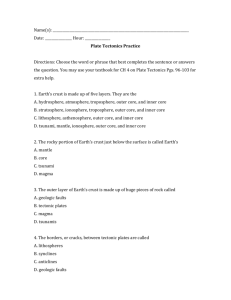Layers Of Earth and Continental Drift Assessment
advertisement

Layers of Earth & Continental Drift Assessment ¡Read the directions for each section, and each question carefully! Multiple Choice: Place the letter on the line that best completes each statement or answers each question. _______1. What are Earth’s layers from the center to the surface? (301.1) A. inner core, outer core, crust, mantle B. crust, mantle, outer core, inner core C. crust, outer core, mantle, inner core D. inner core, outer core, mantle, crust _______2. Workers break up and remove rock as they build a road. They are making a small change to Earth’s (301.1) A. crust. B. outer core. C. mantle. D. inner core. _______3. How do Earth’s crust and mantle differ? (303.1) A. The crust is much thinner and less dense than the mantle. B. The crust is much thinner and denser than the mantle. C. The mantle is much thicker and less dense than the crust. D. The mantle is much thinner and denser than the crust. _______4. Why is the inner core of the earth solid? (303.1) A. The temperature of the core is not hot enough to melt. C. The inner core has an enormous amount of pressure on it. B. The core is made of iron and nickel. D. The inner core is a rock. _______5. Why did scientists reject Wegener’s continental drift hypothesis? (301.1) A. He could not explain how the continents moved. B. The climates of the continents have remained the same. C. Fossil evidence showed the continents were never joined. D. The geology of the continents didn’t support his hypothesis. _______6. A tectonic plate is a slab of Earth’s (301.1) A. crust and lower mantle. B. crust and uppermost mantle. C. uppermost mantle and core. D. lower mantle and core. _______7. Which of the following is also known as a spreading center? (301.2) A. Transform boundary B. Divergent boundary C. Convergent boundary D. Convection boundary _______8. At transform boundaries, two plates (301.2) A. pull away from each other. B. push against each other. C. scrape past each other. D. do not move in any direction. _______9. Tectonic plates that slide above or below each other are known as a (301.2) A. transform boundary. B. divergent boundary. C. convergent boundary. D. convection boundary. _______10. Why do most earthquakes occur at tectonic plate boundaries? (301.2) A. There is little or no movement of rock in these areas. B. Large amounts of stress build up as plates move. C. Very little stress builds up along tectonic plate boundaries. D. Most faults occur in the middle of the tectonic plates. _______11. The Crust of the Earth is often referred to as the (301.1) A. Lithosphere B. Asthenosphere C. Mantle D. Core _______12. The layer that makes up the greatest amount of the Earth’s mass is the (301.1) A. inner core. B. crust. C. mantle. D. outer core. _______13. Scientists believe that the outer core is (303.1) A. rocky. B. solid. C. liquid. D. frozen. _______14. Scientists believe that the inner core is (303.1) A. liquid. B. rocky. C. frozen. D. solid. 15. The diagram below represents Earth, label the following: Core, Mantle, Crust (303.1) 16. The diagram below represents Earth, label the following: Inner Core, Outer Core, Lithosphere, Asthenosphere (303.1) 17. Use the picture and space below to draw (using arrows) and explain (using words) how convention currents work. (301.1) Name:_________________________ Date:__________ Block:_____ Score:_____








